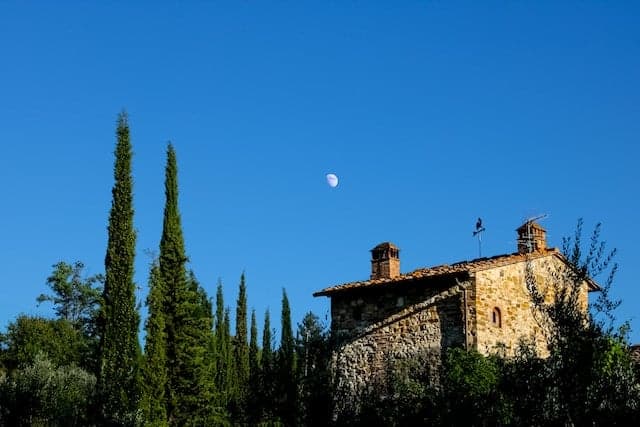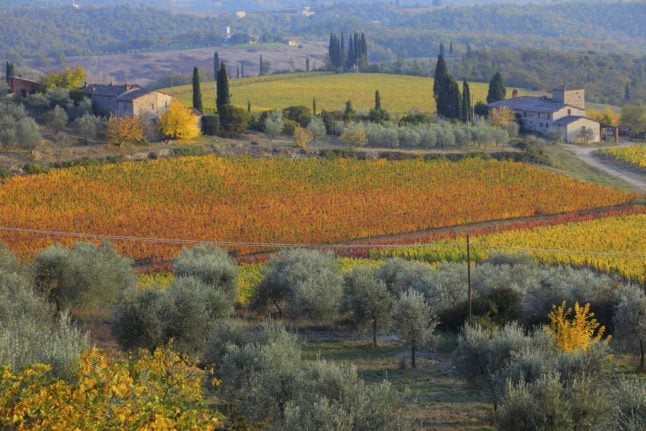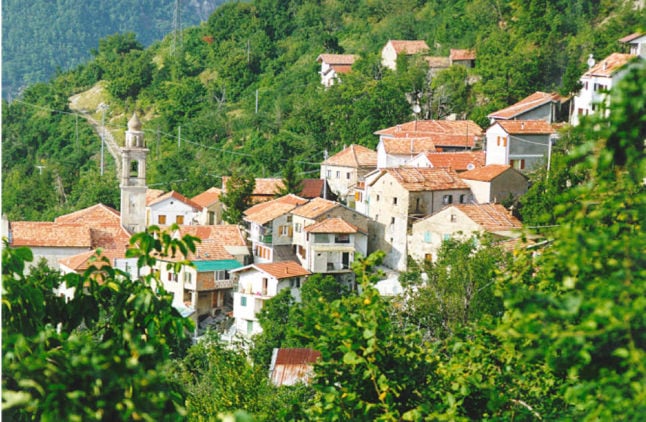Tuscany or Basilicata? How Italy's international property market is changing

From typical budgets to preferred locations and property types, Silvia Marchetti looks at how the profile of the average foreign buyer looking for a slice of Italian life has changed over the years.
Nearly 20 years ago, I remember when Tuscany was dubbed ‘the Tuscanshire of Italy’ in honour of all the wealthy Brits (and Americans, too) who had bought luxury farmsteads and castelletti amid cypress-lined paths and green rolling hills. Singer Sting had purchased a villa there alongside other VIPs and European royals.
Then, some 10 years later a new trend emerged: ‘Tuscanshire’ turned into ‘Abruzzoshire’, with local press talking up the arrival of English-speaking expats who wanted to live their Italian dream in a wilder, albeit poorer and more remote, region roamed by sheep, wolves and bears.
READ ALSO: The hidden costs of buying a home in Italy
There’s been a significant change in the profile of foreign home buyers in Italy, from high-end to middle-class.
Before it was usually well-off people that relocated from abroad to Tuscany and Umbria spending tons of money for castles and mansions, or luxury attics in big cities. Some still do, but they like to keep a low profile.
Surprisingly, many top destinations are now down south. I was rather shocked by the latest real estate report issued by the Agenzie delle Entrate, Italy's tax authority: in 2022 the region of Basilicata had the second-most home purchases in Italy, after Lombardy.
Even though the report does not clarify how many of these purchases were made by foreigners, local Basilicata mayors who have launched projects to lure new residents say it is very likely that over 80 percent of the new buyers came from abroad.

Tuscany has long been the dream location, but many foreign buyers are now looking further afield. (Photo by FABIO MUZZI / AFP)
This is for the simple fact that Italian families leave, every year, Basilicata, Molise and parts of Calabria in search of a brighter future elsewhere. Depopulation in the south, alongside low birth rates, remain problems which local authorities are trying to fight by appealing to foreign home buyers.
IN MAPS: How Italy’s property prices vary by region
While in the past it was all about the rich who flocked to Liguria, Sardinia and Emilia Romagna to enjoy their beach-side mansions, now it’s mostly middle class or lower-income foreign nationals who make global headlines, lured by the rural appeal of depopulated southern villages, or retirees who crave for a cheaper lifestyle under the sultry Calabrian sun, close to the sea.
This trend has mostly been triggered by a series of measures that the town halls of these ‘dying’ villages have put in place, from 'one euro' to cheap turnkey homes, ‘baby bonuses’ for families willing to relocate, tax breaks, lower bills and financial aid for starting a new business.
READ ALSO: The Italian towns launching alternatives to one-euro homes
But it is not only due to such schemes. Life is cheaper in many parts in Italy compared to anywhere else in the world, and this is most true particularly in small villages, even northern ones.
In the Alpine hamlet of Carrega Ligure, on the border between Piedmont and Liguria, old farmer homes are on sale starting at 10,000 euros.

Council officials in the village of Carrega Ligure have tried to sell off abandoned properties at low prices. Credit: Comune di Carrega Ligure
Retired foreigners with a modest pension end up saving a lot of money embracing the rural idyll, even in villages close to Rome. In the hamlet of Capena close to the Tiber River, a two-bedroom apartment in the medieval center costs about 30.000 euros. Such convenient prices tend to lure not just retired couples but also millennial teleworkers on a budget.
What is staying the same however is the high-end, ultra-wealthy segment of buyers of luxury villas and studios who still crave Italy’s two top cities.
Lombardy, with Milan as its capital, leads the way ahead of Rome. According to a survey by luxuryestate.com, a partner of Italian property site immobiliare.it, 9 percent of all super-rich European buyers looking for a lavish apartment in Italy pick Milan, while 8 percent choose Rome.
In Milan, nearly 30 percent come from the UK, while 20 percent are Swiss. I met a rich Belgian family in Brussels once who said they had bought a panoramic attic overlooking the Duomo to use just for ‘parachute shopping’ when they’d hop on a plane for the weekend to ransack the Fashion Quadrangle.
OPINION: Bargain homes and fewer crowds - but Italy’s deep south is not for everyone
Such clients want turnkey mansions with no need of renovation work, not even minimal fixes - totally the opposite from those who buy cheap homes in the rural south and often end up renovating them on their own.
I think this gap between ‘rich city home buyers’ and ‘middle class rural fixer-uppers' is bound to widen as inflation keeps rising and the spending power of the less wealthy will drop further.
While Italy’s big cities will always represent an eternal dream of glamour, a status symbol for the wealthy, small southern villages and rural spots by contrast offer the perfect compromise for a financially sustainable Italian lifestyle.
See more in The Local's property section.
Comments
See Also
Nearly 20 years ago, I remember when Tuscany was dubbed ‘the Tuscanshire of Italy’ in honour of all the wealthy Brits (and Americans, too) who had bought luxury farmsteads and castelletti amid cypress-lined paths and green rolling hills. Singer Sting had purchased a villa there alongside other VIPs and European royals.
Then, some 10 years later a new trend emerged: ‘Tuscanshire’ turned into ‘Abruzzoshire’, with local press talking up the arrival of English-speaking expats who wanted to live their Italian dream in a wilder, albeit poorer and more remote, region roamed by sheep, wolves and bears.
READ ALSO: The hidden costs of buying a home in Italy
There’s been a significant change in the profile of foreign home buyers in Italy, from high-end to middle-class.
Before it was usually well-off people that relocated from abroad to Tuscany and Umbria spending tons of money for castles and mansions, or luxury attics in big cities. Some still do, but they like to keep a low profile.
Surprisingly, many top destinations are now down south. I was rather shocked by the latest real estate report issued by the Agenzie delle Entrate, Italy's tax authority: in 2022 the region of Basilicata had the second-most home purchases in Italy, after Lombardy.
Even though the report does not clarify how many of these purchases were made by foreigners, local Basilicata mayors who have launched projects to lure new residents say it is very likely that over 80 percent of the new buyers came from abroad.

This is for the simple fact that Italian families leave, every year, Basilicata, Molise and parts of Calabria in search of a brighter future elsewhere. Depopulation in the south, alongside low birth rates, remain problems which local authorities are trying to fight by appealing to foreign home buyers.
IN MAPS: How Italy’s property prices vary by region
While in the past it was all about the rich who flocked to Liguria, Sardinia and Emilia Romagna to enjoy their beach-side mansions, now it’s mostly middle class or lower-income foreign nationals who make global headlines, lured by the rural appeal of depopulated southern villages, or retirees who crave for a cheaper lifestyle under the sultry Calabrian sun, close to the sea.
This trend has mostly been triggered by a series of measures that the town halls of these ‘dying’ villages have put in place, from 'one euro' to cheap turnkey homes, ‘baby bonuses’ for families willing to relocate, tax breaks, lower bills and financial aid for starting a new business.
READ ALSO: The Italian towns launching alternatives to one-euro homes
But it is not only due to such schemes. Life is cheaper in many parts in Italy compared to anywhere else in the world, and this is most true particularly in small villages, even northern ones.
In the Alpine hamlet of Carrega Ligure, on the border between Piedmont and Liguria, old farmer homes are on sale starting at 10,000 euros.

Retired foreigners with a modest pension end up saving a lot of money embracing the rural idyll, even in villages close to Rome. In the hamlet of Capena close to the Tiber River, a two-bedroom apartment in the medieval center costs about 30.000 euros. Such convenient prices tend to lure not just retired couples but also millennial teleworkers on a budget.
What is staying the same however is the high-end, ultra-wealthy segment of buyers of luxury villas and studios who still crave Italy’s two top cities.
Lombardy, with Milan as its capital, leads the way ahead of Rome. According to a survey by luxuryestate.com, a partner of Italian property site immobiliare.it, 9 percent of all super-rich European buyers looking for a lavish apartment in Italy pick Milan, while 8 percent choose Rome.
In Milan, nearly 30 percent come from the UK, while 20 percent are Swiss. I met a rich Belgian family in Brussels once who said they had bought a panoramic attic overlooking the Duomo to use just for ‘parachute shopping’ when they’d hop on a plane for the weekend to ransack the Fashion Quadrangle.
OPINION: Bargain homes and fewer crowds - but Italy’s deep south is not for everyone
Such clients want turnkey mansions with no need of renovation work, not even minimal fixes - totally the opposite from those who buy cheap homes in the rural south and often end up renovating them on their own.
I think this gap between ‘rich city home buyers’ and ‘middle class rural fixer-uppers' is bound to widen as inflation keeps rising and the spending power of the less wealthy will drop further.
While Italy’s big cities will always represent an eternal dream of glamour, a status symbol for the wealthy, small southern villages and rural spots by contrast offer the perfect compromise for a financially sustainable Italian lifestyle.
See more in The Local's property section.
Join the conversation in our comments section below. Share your own views and experience and if you have a question or suggestion for our journalists then email us at [email protected].
Please keep comments civil, constructive and on topic – and make sure to read our terms of use before getting involved.
Please log in here to leave a comment.